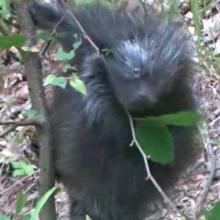Erethizon dorsatum
Common name:
North American porcupine
Genus:
Erethizon
Family:
Erethizontidae
Suborder:
Hystricomorpha
Erethizon dorsatum
Common name:
North American porcupine
Genus:
Erethizon
Family:
Erethizontidae
Suborder:
Hystricomorpha
Erethizon dorsatum
Common name:
North American porcupine
Genus:
Erethizon
Family:
Erethizontidae
Suborder:
Hystricomorpha
Family (Animalia): Erethizontidae
The New World porcupines, family Erethizontidae, are large arboreal rodents, distinguished by their spiny coverings from which they take their name. They inhabit forests and wooded regions across North America, and into northern South America. Although both the New World and Old World porcupine families belong to the Hystricognathi branch of the vast order Rodentia, they are quite different and are not closely related.
Characteristics
New World porcupines are stout animals, with blunt, rounded heads, fleshy, mobile snouts, and coats of thick, cylindrical or flattened spines ("quills"). The spines are mixed with long, soft hairs. They vary in size from the relatively small prehensile-tailed porcupines, which are around 30 cm (12 in) long, and weigh about 900 g (32 oz), to the much larger North American porcupine, which has a body length of 86 cm (34 in), and weighs up to 18 kg (40 lb).
They are distinguished from the Old World porcupines in that they have rooted molars, complete collar bones, entire upper lips, tuberculated soles, no trace of first front toes, and four teats.
They are less strictly nocturnal than Old World species in their habits, and some types live entirely in trees, while others have dens on the ground. Their long and powerful prehensile tails help them balance when they are in the tree tops. Their diets consist mainly of bark, leaves, and conifer needles, but can also include roots, stems, berries, fruits, seeds, nuts, grasses, and flowers. Some species also eat insects and small reptiles.
Solitary offspring (or, rarely, twins) are born after a gestation period of up to 210 days, depending on the species. The young are born fully developed, with open eyes, and are able to climb trees within a few days of birth.
Reference: Wikipedia

